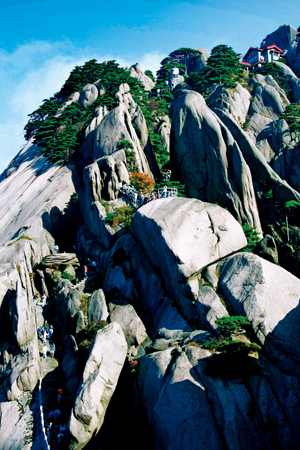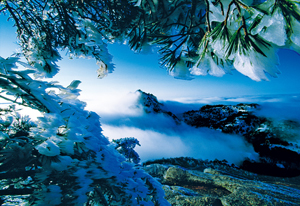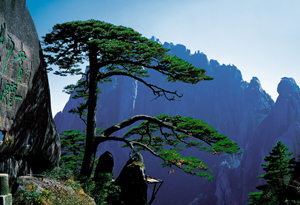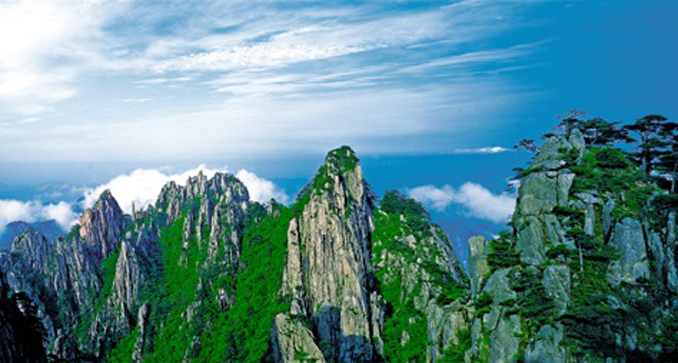Written by: Feng Yang
Posted on: September 04, 2013 |  | 中文
| 中文
To enjoy the magnificence of a mountain, you have to look upward in most cases. To enjoy the magnificence of Mount Huangshan, however, you've got to look downward. In this 154 square kilometer-scenic area in southern Anhui Province, there are 77 peaks. Once on top of any of these peaks, you will have a bird's-eye-view of cluster upon cluster of peaks rising in the distance from beneath a sea of clouds. These appear so close to one another that you'll actually see a forest of peaks.
 |
The Lotus Peak, 1,862 meters above sea level, is the highest of all peaks. It is thus called because it looks like a blossoming lotus flower. The Guangming Peak, the second highest, rises 1,841 meters above sea level, which has a flat top, ideal for watching the rising sun and the boundless sea of clouds below. An old saying goes like this: You'll miss the scenic beauty of Mt. Huangshan without climbing to the top of the Guangming Peak. The third highest peak is called Tiandu, which means "heavenly capital." Though not as high as Lotus and Guangming, it is, however, the most imposing and the steepest. The Tiandu Peak epitomizes the wonders of Mount Huangshan and is called "the best" of the peaks. A dozen peaks, including the three highest, are open to climbers. The other peaks are simply inaccessible.
On all these peaks you'll find rocks of exotic shapes. A large rock may look like a precipitous cliff, and a small rock like a tree in miniature. There are also rocks that look like human figures or animals. Some do not look like any real thing, but they are beautiful all the same, with looks so splendid in shape as to beggar description.
When you're atop one of these peaks, don't forget to look around. Peaks or rocks in the distance would present different views when seen from different directions. When looking at the Tiandu Peak from Yuping Peak, you see something like a squirrel on a neighboring peak ready to jump to the Tiandu Peak. The "squirrel," so to speak, is a rock. Once you are atop the Tiandu Peak, the same rock looks just like an odd shoe.
Pine trees in Mount Huangshan cliffs are no less beautiful than those rocks. Most pine trees here grow in places that rise at least 800 meters above sea level and are often rooted in crevices of granite rocks with hardly any soil. Moreover, they vary in height. The highest can be several dozen meters high, and the shortest may just be 10 or 20 centimeters tall. Their trunks and branches are crooked and their crowns are often flat. By Chinese aesthetic standards, the more crooked a plant is, the more beautiful it will be. Strange shapes, as a matter of fact, constitute one salient feature for pine trees in Mount Huangshan.
Why is it that pine trees can grow in crevices of granite rocks? This has something to do with the root system of the tree. The roots of pine trees in Mount Huangshan can secrete a kind of organic acid, which, together with the carbon dioxide released from the roots, forms a kind of carbonic acid when meeting with water. The carbonic acid slowly melts the rock and helps the tree roots to get nutrition and water from the rock. As a result, the roots go down deeper and deeper. In general, the length of a pine tree’s root can be several times the height of the tree itself. In addition, pine trees here are good at protecting themselves. Their needles are exceptionally short and hard, and this helps reduce evaporation of the precious moisture.
 |
Pine trees grow extremely slowly because of harsh natural conditions. Even a small pine tree may be several hundred years old. However, they never wither and are resilient against strong wind and heavy snow. The higher the mountain peak is, the greener are the trees there. Back in the 1930s, botanists identified pine trees in Mount Huangshan as belonging to an independent pine species, which they named after Mount Huangshan. For its tenacity and vitality in resisting natural adversities, the Mount Huangshan pine is seen as a symbol of willpower and has been chosen as the logo of the Anhui Province.
 |
For about 250 days a year, clouds add to the beauty and magnificence of Mount Huangshan. When the clouds are thick, peaks in the distance will look like isles on the turbulent sea. Looking around, you find that far, far away, probably several hundred kilometers away, clouds converge round peaks, forming an ocean that seems to engulf the world. The sea of clouds inspired the ancient Chinese to call Mount Huangshan the "Huangshan Sea." The names of many scenic spots in the area are associated with the sea, such as the "South Sea," the "North Sea," etc.
The sea of clouds appears in Mount Huangshan on an average of 52 times a year. The best time to view it is from November to April of the following year. Sometimes, it appears at sunrise or sundown. If you're lucky enough to be there, you'll see a sea of rosy clouds.
Peaks, rocks, pine trees and clouds together form scenes with a strong enough visual impact to give a free hand to people's imaginations, hence those poetic - if not strange – names given to scenic spots on Mount Huangshan: the Tiandu (heavenly capital) Peak, Buddha's Palm Peak, Xianrenzhilu (god showing the way) peak, and the Peak of Old Man Picking Herbs, to name a few. Some scenes are named after their shapes, such as the Lotus Peak, the Qintai Peak (platform for the traditional Chinese plucked instrument called "qin"), Fan-shaped Pine Tree, etc. Some names contain both people's imagination and feelings: Farming in the Cloud Peak, Old Man Fishing Peak, and Guest Greeting Pine. Some of the names have historical stories or folk tales behind them. Viewers with different cultural backgrounds may have different imaginations when looking at the same scene. No wonder some say Mount Huangshan is a "great garden of folk culture."
 |
Strange-looking pine trees, grotesque rocks and the sea of clouds are the most enchanting scenes Mount Huangshan is able to present. Once upon a time, there was a man who did not believe in this. He made up his mind to go to Mount Huangshan himself to see whether the mountain was really as beautiful as it had been said. After he visited just a few of the peaks, he became convinced that Mount Huangshan was really as beautiful as it had been described. One of the peaks was thus named as "Shixin," literally "one is convinced only after one comes and sees for oneself.”
Mount Huangshan is unique in many ways. An old saying goes like this: "Other mountains stand out with their different shapes, which one can see with one's own eyes. But the scenery in Mount Huangshan changes constantly, and one can never see enough of it."
Probably for this reason, Mount Huangshan is a ‘taboo’ for those who write with the Chinese language. Those who proved excellent in writing about other mountains often felt at a loss about what to do with this mountain, and some even gave up writing about it. More than 20,000 poems and essays have been written about Mount Huangshan since ancient times, and none is good enough to be a masterpiece. But these lines from an essay have been frequently quoted: "No mountain can match Mount Huangshan in beauty. Once on top of Mount Huangshan, one instantly becomes apathetic towards all other mountains!"
However, Mount Huangshan has always been a favorite for the ancient Chinese literati landscape painters. Mountain peaks, the sea of clouds, strange-looking pine trees and grotesque rocks: these were living things in their mind's eye, something that was good enough to reflect their proud inner world. Many famous mountains and valleys were subjects under the paintbrush , but Mount Huangshan was always the most favored subject in traditional Chinese landscape painting. Of the various schools of traditional Chinese painting, only one school is named after a mountain, and that mountain is none other than Mount Huangshan. Jian Jiang (1610-1664), Mei Qing (1623-1679) and Shi Tao (1642-1718) have been known as the best painters of this school. Shi Tao once said: "Mount Huangshan is my teacher, and I am Mount Huangshan's friend."
 |
In May 1990, a group of experts from UNESCO made an inspection tour of Mount Huangshan. In June, they asked the Chinese side to get Mount Huangshan listed as a site of both natural and cultural heritage for the world. It was only then that the Chinese realized that they had underestimated the value of Mount Huangshan.
You may also like: